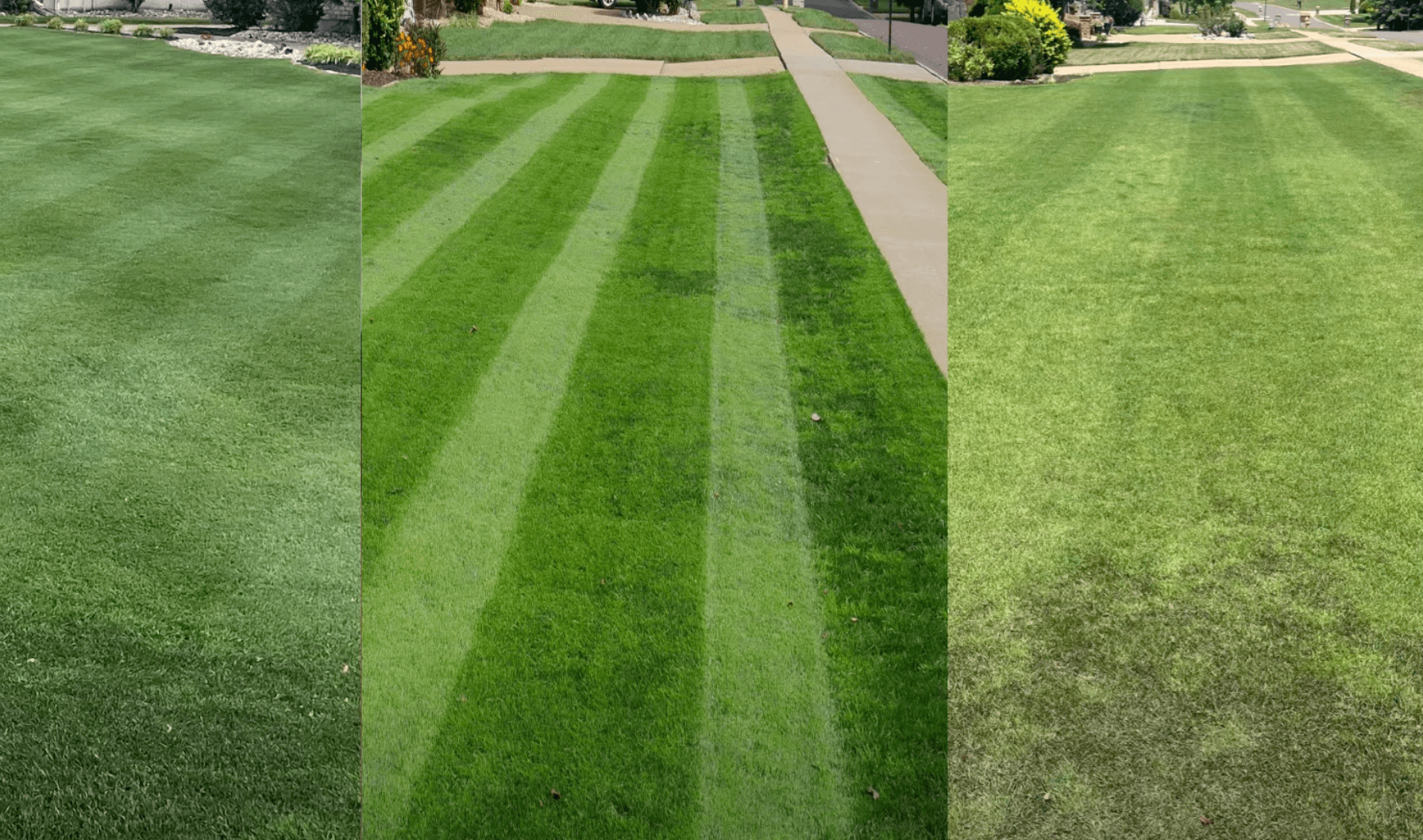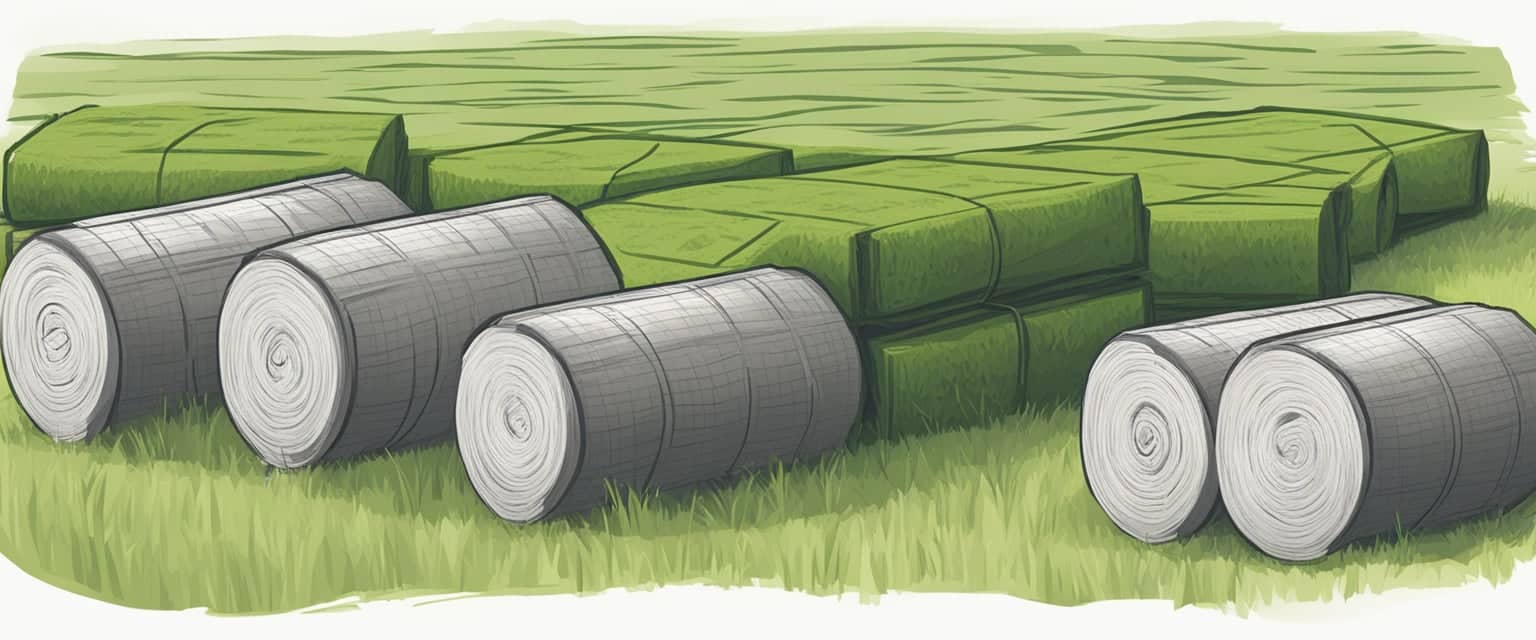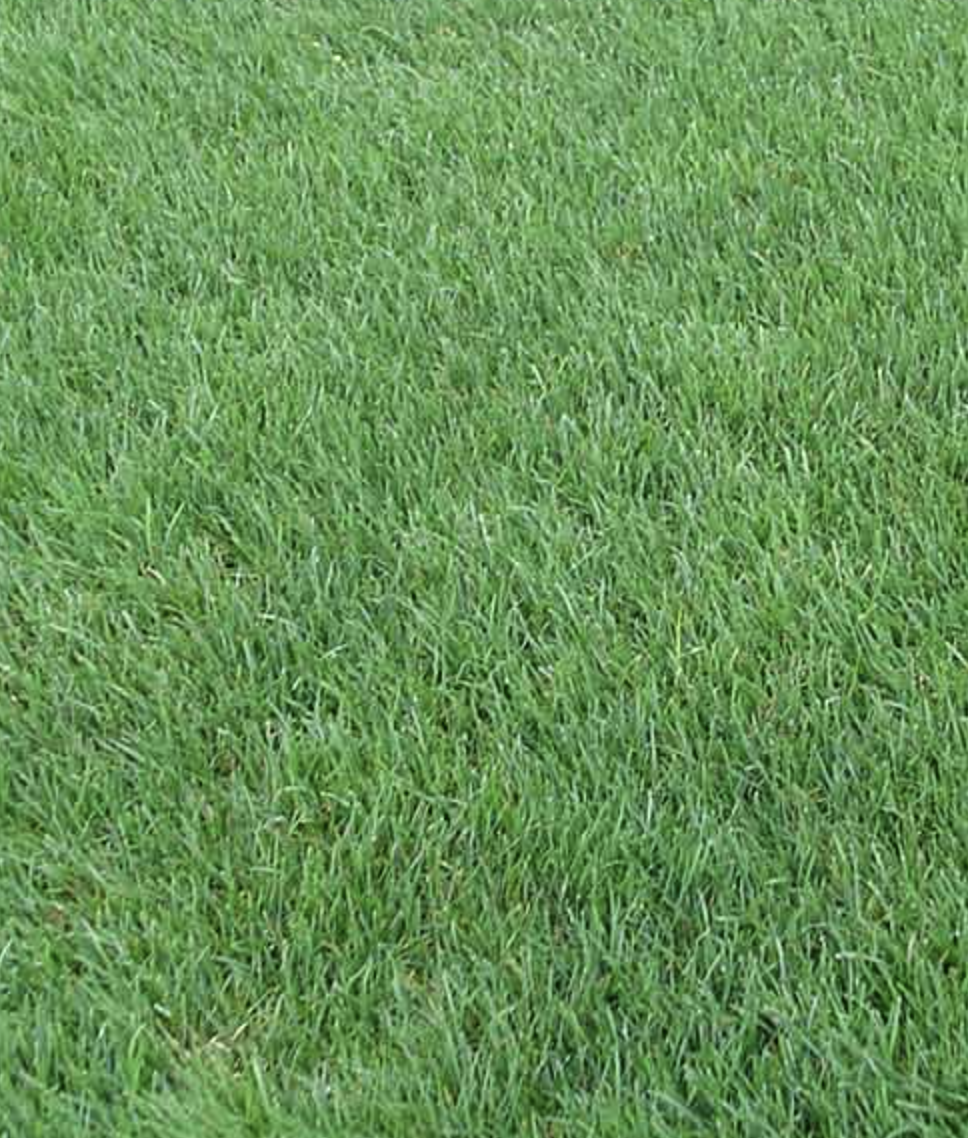In this guide to Perennial Ryegrass, we'll discuss everything from cost to best mowing height while also looking at the pros and cons. By the end, you'll be perfectly positioned to know whether it's the right sod type for you.
What Is Perennial Ryegrass Sod?
Perennial ryegrass sod is a type of grass. It's popular for its quick establishment and fine texture. Sod farms grow it. Then they harvest it in rolls or slabs.
Characteristics of Perennial Ryegrass Sod:
Fine Texture: It has thin blades that feel soft.
Quick Establishment: It roots fast. That's great for urgent lawn projects.
Durable: It can handle foot traffic.
Year-round Green: It stays green throughout the seasons, hence 'perennial'.
Cool-Season Grass: It thrives in cooler climates and seasons.
Uses:
Lawns: Homeowners love it for their yards.
Sports Fields: It's ideal for fields. It recovers quickly from wear.
Erosion Control: It helps to prevent soil erosion.
Farming & Installation:
Farmers grow it in fields. They ensure top quality.
They cut it into pieces for transport.
People lay down the sod. They need to water it often at first. It bonds with the soil below soon after.
Remember, it needs sunlight and water. Also, it's not as heat-tolerant as other grasses. But it's a champion in cooler spots. It makes for a lush, vibrant lawn. So, if you're after a green yard fast, perennial ryegrass sod might be your best buddy.
Defining Features
Perennial ryegrass sod, known for quick establishment, packs a real punch in the world of turf. It sports a fine texture and boasts a rich green hue. People love its shine under the sun!
Appearance
Texture: Fine and smooth
Color: Deep green with a natural sheen
Growth Habits
Speed: Fast-growing, establishing quickly
Rooting: Deep roots for drought tolerance
Maintenance
Mowing: Flourishes with regular mowing
Watering: Requires moderate watering
Fertilization: Annual feeding keeps it lush
One thing's for sure – it doesn't do well in shade. This grass loves the spotlight, thriving in full sunlight. The sod's density is a winner for heavy foot traffic areas.
Think the perfect playing field!
Plus, it's a cool-season all-star. It maintains its composure even when temperatures dip. But remember, it might need a buddy in severe cold. Add a mix of other grasses to help it survive chilly winters.

When to Lay Perennial Ryegrass Sod
The best time to lay perennial ryegrass sod is when the soil is ready and the light is just right. Timing is everything.
Soil Conditions
Soil Temperature: Ideal soil temperatures for laying perennial ryegrass sod should be between 50°F and 65°F. Sod roots best when it's not too hot or too cold.
Soil Preparation: Before laying, the soil must be cleared of debris and loosened. One should add organic matter if necessary to provide a nutrient-rich base. Make sure the land is level.
Light Conditions
Sunlight Exposure: Perennial ryegrass loves full sun. Aim for a spot that gets at least 6 hours of direct sunlight per day.
Shade Tolerance: While it prefers sun, this grass can handle some shade. However, areas with heavy shade might not be suitable for perennial ryegrass sod.
Where to Buy Perennial Ryegrass Sod
Perennial ryegrass sod is easy to find if you know where to look. They can purchase it at a variety of spots. Garden centers and sod farms often carry high-quality options.
Local Garden Centers:
Typically offer fresh sod.
Experts can provide advice.
Prices may vary by location.
Sod Farms:
Specialize in fresh-cut sod.
They may offer delivery.
Buyers can usually inspect before purchase.
Online Retailers:
Convenient home delivery.
A wide selection to choose from.
Look for trusted, well-reviewed sellers.
Home Improvement Stores:
Some stock sod seasonally.
It's a quick, local option for buyers.
Tips for Buyers:
Always check sod quality.
Sod should be green and vibrant.
It should look healthy and well-rooted.
Remember, prices differ from place to place. Customers should also consider the shipping cost if they're buying online. A little research goes a long way. They should compare different sources to find the best deal.
A Note on Measurement: Rolls, Pallets and Square Feet

When you're sizing up perennial ryegrass sod for your lawn, three main terms will strike your eye: rolls, pallets, and square feet. Let's unpack these one by one.
Level Up Your Lawn Skills
Once per week we'll send you an interview from someone who has mastered the art of lawn care.
Sod Rolls: This is the individual piece of sod you'll lay down. They're like the slices of bread for your lawn sandwich! Each roll is usually about 24 inches wide by 54 inches long. But sizes may vary, so always check with your supplier.
Pallets: A pallet bundles several rolls together. They're the bulk-pack you buy to cover larger areas. How many rolls on a pallet? Well, that's a "depends-on-the-supplier" answer. Some might stack 50, others 75. It's best to ask them directly or consider the insights available in a definitive guide to get specific numbers for your region.
When it comes to Square Feet, it’s simple math. A sod roll x by y inches will cover x*y/144 square feet. Pallets will multiply this by the number of rolls included. Knowing your lawn's square footage is vital. Measure your lawn's length and width and multiply to get the answer.
If you're plotting a sod revolution in Colorado, for example, square footage helps you estimate costs accurately before you embark on the transformation. Getting familiar with regional specifics can save headaches and a hit to the wallet, as highlighted by local experts in sod landscaping.
Always remember: Whether you're sowing seeds or laying sod, precision pays off. And that also goes for measuring your space. A little homework before you buy can make a whole lot of difference.
Choosing an Installation Company
When picking a company to install perennial ryegrass sod, homeowners should focus on reputation, experience, and cost transparency.
A Note on Estimates: Prices, Quotes, and the Actual Cost
Companies may offer free estimates, but the final cost can differ. They should provide a detailed quote. This quote usually includes:
Labor: The manpower to lay the sod.
Materials: The cost of the sod and any extra soil.
Preparation: Fees for site prep before installation.
Travel: Charges based on the company’s travel to the site.
Homeowners need to ask if the quote is fixed or subject to change. A fixed quote means the price shouldn't budge. If it's variable, unexpected costs could pop up. They should always have the company explain any potential additional fees.
When comparing quotes, they shouldn't just glance at the bottom line. Homeowners must scrutinize what is included. They may find that some companies toss in extras. These can be things like post-installation care advice or guarantees.
One last pointer: Watch out for oddly low prices. They can mean low-quality sod or hidden costs. A good company keeps it real with pricing. They don't lure customers with deals that are too good to be true.
Key Characteristics of Perennial Ryegrass
Perennial ryegrass sod shines with its toughness and cool-season growth patterns. Here’s the lowdown on what makes it a top pick.
Durability and Resilience
Perennial ryegrass is like the superhero of the turf world. It can handle foot traffic like a champ. Its dense growth means it recovers fast from wear and tear.
Dormant Season
It's a cool-season grass but doesn't love the cold too much. When the mercury dips, it slows down and might take a nap. It'll turn brown but bounces back when warmer weather rolls in.
Drought Tolerance
Okay, so it's not a cactus. It does need regular drinks to stay lush and green. When water is short, it'll stress out a bit. Frequent watering keeps it happiest.
Cold Tolerance
Perennial ryegrass can handle a chill, but harsh winters can rough it up. Moderate cold? No biggie. But really freezing temps can be a problem. Still, it's tougher in the cold than some of its grassy cousins.
How to Care for Perennial Ryegrass
Perennial Ryegrass needs regular upkeep to thrive. They make sure it's lush, healthy, and green. Now, here's how to nail it.
Cleaning and De-Thatching
Periodically, lawns get clogged with dead grass, called thatch. It's important to remove it. Spring is a great time to de-thatch, giving the grass room to grow. Use a thatching rake or rent a power de-thatcher.
Core Aerating
Soil gets compacted over time. Aerating helps. It allows air and water to penetrate. By pulling cores of soil out, these folks make space for roots to expand. Do this annually, preferably in the fall.
Mowing
They keep the blade sharp, and they mow high. Cutting more than 1/3 of the grass height stresses the lawn. Aim for a height of 2 to 3 inches, and mow regularly during the growing season.
Watering
They know the importance of hydration. Water deeply but infrequently to encourage root growth. Aim for 1 inch of water per week, whether from rain or manually watering.
Fertilizing
Grass craves nutrients. They feed it with a balanced fertilizer in the spring and fall. Nitrogen is key—overdoing it can harm the grass and environment. A soil test can show what their lawn specifically needs.
Controlling Pests
Grubs and insects sometimes move in. They keep an eye out for pests and diseases. When spotted, they act fast. There are chemical and natural options to keep critters at bay and the lawn safe.
Pros & Cons of Perennial Ryegrass Sod
Pros:
Quick Establishment: Perennial ryegrass sod sets down roots fast. They've got a knack for growing quickly.
Cold Tolerant: It can handle chilly weather. Not a fan of the cold? This grass has got your back.
Disease Resistant: It fights off sickness like a champ. No one likes a sick lawn.
Fine Texture: It’s soft and fine. It looks pretty slick in a yard.
Traffic Tolerant: It can take a beating. Kids and pets? Bring it on.
Pros | Description |
Quick Establishment | Sets down fast, grows quickly. |
Cold Tolerant | Handles the cold well. |
Disease Resistant | Stays healthy, less fuss. |
Fine Texture | Looks good with its soft, fine blades. |
Traffic Tolerant | Perfect for high foot traffic areas. |
Cons:
High Maintenance: It needs more TLC. Mowing and watering are a must.
Short-Lived: Doesn’t last as long as other grasses. They need reseeding.
Water-Hungry: It’s always thirsty. Keep the water coming.
Not Shade Friendly: It loves the sun and fades in the shade.
Cons | Description |
High Maintenance | Frequent mowing and watering required. |
Short-Lived | Needs reseeding more often than other grasses. |
Water-Hungry | Requires a lot of water to stay green. |
Not Shade Friendly | Struggles in low-light areas. |
Perennial ryegrass sod is a cool-season grass with a boatload of pluses, especially if you want a lawn that's ready for action fast. But remember, it asks for a bit more from you in return.
Frequently Asked Questions
Here are some common questions with straight facts to help you understand perennial ryegrass sod better.
Can perennial ryegrass survive the heat during summer months?
Perennial ryegrass prefers cooler climates. However, it can handle some heat with proper watering and care. In hot areas, it may struggle and need more attention.
What temperature range is best for perennial ryegrass germination?
Perennial ryegrass germinates best when soil temperatures are between 50 to 65 degrees Fahrenheit. This typically happens in the spring and fall.
Are there any drawbacks to choosing perennial ryegrass for my lawn?
Perennial ryegrass can be less tolerant to extreme heat and drought when compared to other grasses. It may require more water and care in warm climates. Its fast growth also means more frequent mowing.
Does it take long for perennial ryegrass to fully establish once laid?
Perennial ryegrass establishes quickly. Typically, it will root in 5 to 10 days and can be ready for light traffic in 3 to 4 weeks after planting.
Perennial Ryegrass versus other types of sod
- Perennial Ryegrass vs. Bermuda comparison →
- Perennial Ryegrass vs. Buffalo comparison →
- Perennial Ryegrass vs. Zoysia comparison →
- Perennial Ryegrass vs. Tall Fescue comparison →
- Perennial Ryegrass vs. Kentucky Bluegrass comparison →
- Perennial Ryegrass vs. St. Augustine comparison →
- Perennial Ryegrass vs. Centipede comparison →
- Perennial Ryegrass vs. Fine Fescue comparison →
- Perennial Ryegrass vs. Bahia comparison →
Level Up Your Lawn Skills
Once per week we'll send you an interview from someone who has mastered the art of lawn care.

